 (a) Schematic of the self-wavelength-swept laser using active optomechanics. (b) Scanning electron microscope (SEM) image of the still HCG and its self-oscillation at fundamental mode. The fast scanning rate of the SEM produces a stroboscopic effect that leads to a periodic distortion of the self-oscillating HCG bars in the SEM image. (c) The time-resolved lasing wavelength of an HCG-VCSEL.
(a) Schematic of the self-wavelength-swept laser using active optomechanics. (b) Scanning electron microscope (SEM) image of the still HCG and its self-oscillation at fundamental mode. The fast scanning rate of the SEM produces a stroboscopic effect that leads to a periodic distortion of the self-oscillating HCG bars in the SEM image. (c) The time-resolved lasing wavelength of an HCG-VCSEL.
The coupling of an optical field and a mechanical oscillator through forces induced by light has been a subject of long-standing interest and an important tool to study fundamental physics. Numerous experiments have used light-induced forces in optical cavities to demonstrate phenomena such as laser cooling and regenerative oscillation. The prevalent research focuses on passive optomechanics, in which a passive optical cavity housing a mechanical oscillator interacts with a population of circulating photons produced by an external laser.
In 2015, we experimentally demonstrated a scheme with an active optical oscillator (laser) and mechanical oscillator integrated in the same cavity.1 The resultant impacts are twofold. First, this marks a new era for optomechanics, from passive to active cavities. Compared with a typical passive optomechanical system, active cavities show an orders-of-magnitude stronger light–matter interaction, with regenerative mechanical oscillation having an amplitude 1,000 times larger than typical.
Second, the optomechanical laser is able to self-sweep its wavelength across 23 nm without any need for external modulation. The sweeping frequency can be as large as a few megahertz. This fast, wide-range laser self-swept source is ultra-efficient in power consumption and super compact—exactly what is needed for frequencymodulated continuous-wave lidar, optical coherence tomography and 3-D cameras.
The optomechanical laser is implemented by a high-contrastgrating (HCG), electrically pumped vertical-cavity surface-emitting laser (VCSEL) at 1,550 nm.2 The HCG is an ultra-lightweight (130 pg) grating with near-wavelength period and less than 200 nm thickness, designed to reflect more than 99.5 percent of the surface-normal light and serve as the top mirror of the VCSEL.3 The mirror is held by a micromechanical spring.
Once the VCSEL is DC-biased above threshold, the laser causes the HCG to move by radiation pressure. This changes the laser cavity length and the lasing wavelength. Coupled with the HCG’s reflection spectrum, the change of lasing wavelength leads to a change of intra-cavity optical power, and thus the radiation pressure on the HCG itself. This optomechanical coupling can sustain self-oscillation of the HCG mirror with an unprecedented amplitude of more than 550 nm. We believe that the work could open up new research and applications.
Researchers
W. Yang, S.A. Gerke, K.W. Ng and C.J. Chang-Hasnain, University of California, Berkeley, Calif., USA
Y. Rao and C. Chase, Bandwidth10, Inc., San Jose, Calif., USA
References
1. W. Yang et al. Sci. Rep. 5, 13700 (2015).
2. Y. Rao et al. IEEE J. Sel. Top. Quantum Electron. 19, 1701311 (2013).
3. C.J. Chang-Hasnain and W. Yang. Adv. Opt. Photon. 4, 379 (2012).
